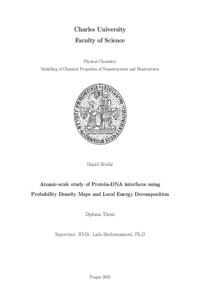Atomic-scale study of Protein-DNA interfaces using Probability Density Maps and Local Energy Decomposition
Studium rozhraní protein-DNA v atomárním měřítku pomocí map hustoty pravděpodobnosti a lokálního rozkladu energie
diploma thesis (DEFENDED)

View/
Permanent link
http://hdl.handle.net/20.500.11956/199827Identifiers
Study Information System: 253189
Collections
- Kvalifikační práce [20838]
Author
Advisor
Referee
Kolář, Michal H.
Faculty / Institute
Faculty of Science
Discipline
Modelling of Chemical Properties of Nanostructures and Biostructures
Department
Department of Physical and Macromolecular Chemistry
Date of defense
3. 6. 2025
Publisher
Univerzita Karlova, Přírodovědecká fakultaLanguage
English
Grade
Excellent
Keywords (Czech)
DNA, protein-DNA interakce, strukturní databáze, data mining, NtC, DFTKeywords (English)
DNA, protein-DNA interactions, structural database, data mining, NtC, DFTTato práce prezentuje přístup ke studiu rozhraní mezi proteiny a DNA pomocí map hustoty pravděpodobnosti, sestavenými analýzou velkého množství strukturních dat. Tato analýza je umožněna použitím lokální klasifikace konformací nukleových kyselin. Cílem bylo získat detailní popis vztahu mezi nukleovými kyselinami a proteiny, což lze využít pro identifikaci vazebných míst nebo tvorbu restrikcí pro makromolekulární docking. Výsledky, vizualizo- vané v podobě map hustoty pravděpodobnosti, umožnily interpretaci dat a nalezení ne- jpravděpodobnějších interakcí mezi proteiny a DNA. Následně byly interakční místa, identi- fikované v mapách, analyzovány pomocí ab initio výpočtů a dekompozice energie, za účelem fyzikálního popisu interakcí a validace výsledků získaných z map hustot pravděpodobnosti.
This thesis presents a novel approach to the study of protein-DNA interfaces using probabil- ity density maps constructed by analyzing a large structural dataset. This analysis is enabled by using local conformation classification for nucleic acids. The aim was to gain a detailed understanding of the relationship between the two molecules, which could be used to identify binding modes or to identify additional restrictions for macromolecular docking. The results of the analyses, visualized in the form of probability density maps, allow interpretation of the data and finding of the most probable interactions between proteins and DNA. Furthermore, interaction sites, identified using the maps, were investigated using ab initio calculations and energy decomposition analysis, to describe the energy landscape of the interaction and validate the results from the probability density maps.
